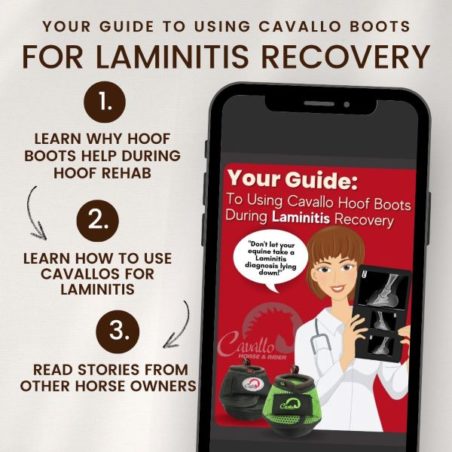A Winter Laminitis Saga
-
February 26, 2023
-
6:47 pm
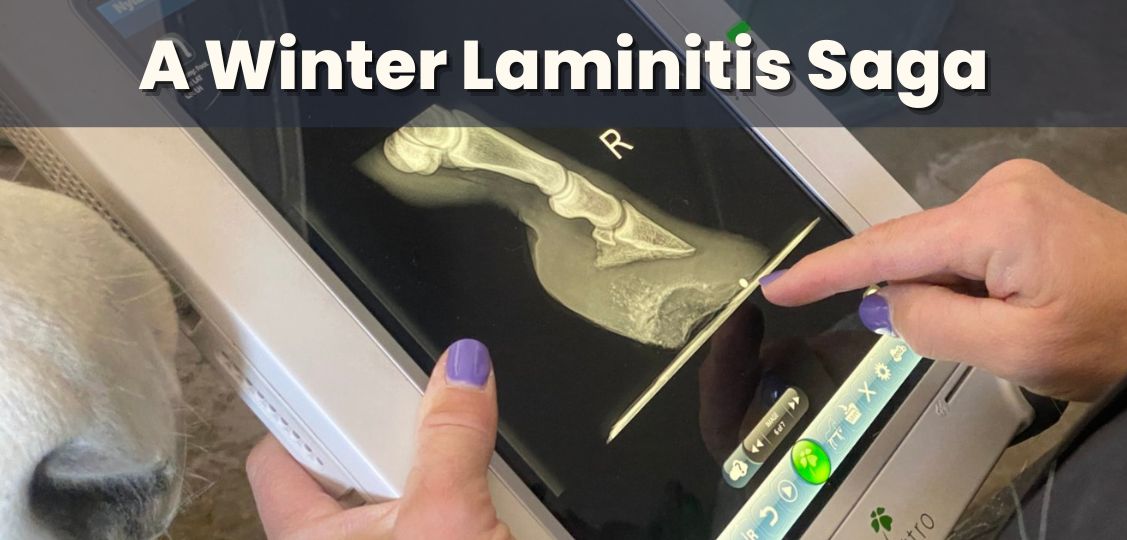
Romeo's Winter Laminitis Troubles
It happens every winter. When the snow and ice build up in the paddock, Romeo the pony suddenly doesn’t want to move. The usually playful and free-moving pony stiffens up, then stands still and squeals when his pasture-mate wants to play. Romeo’s hooves and body hurt. He has been diagnosed with Insulin Resistance and “Winter Laminitis.”
Our friend Heidi Melocco has seen Romeo in pain each of the last five Colorado winters. She knows when it’s time to put on his Cavallo Boots. Here are some words from Heidi about what she’s done to help Romeo ease his pain:
“I was confused when Romeo first had trouble in the winter months,” Melocco says. “He hadn’t had access to too much hay, he doesn’t get grain, he hadn’t switched feeds–none of the usual causes I knew of for Laminitis or founder were present. In the summer, Romeo is fine. He’s even been turned out on grass for short periods without a flare-up. But the winter is tough!”
Winter Laminitis - Finally a Diagnosis that Fits!

“I worked with my veterinarian to get a blood test to see if there was a metabolic component to his winter pain. The test came back with a note that he did have insulin resistance. But there was an extra message on the report– saying his insulin resistance was probably worse from November to March. My veterinarian had never seen that on a report before. It made us both do some research into ‘Winter Laminitis’ –if your horse has pain in the winter, it’s worth a Google search, too.
Immediate Help is Available
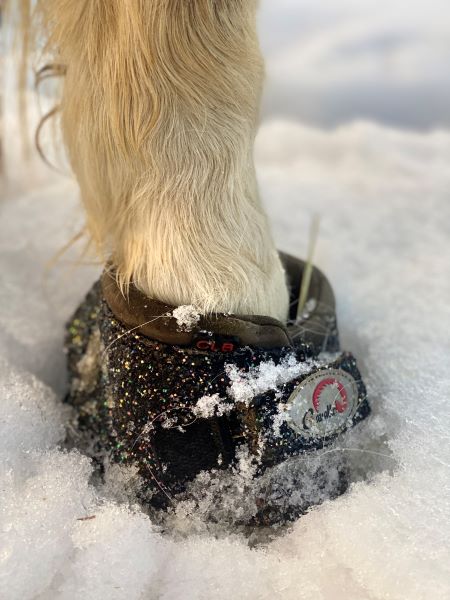
“I read about the importance of warming up horses who have Winter Laminitis–and not soaking their feet if they look like they are standing in a typical laminitic stance. I put Romeo in his stall with a pile of shavings and outfitted him with his set of four sparkly CLB Bling Cavallo Hoof Boots. I have the Cavallo Comfort Pads inside his boots so that his soles are cushioned as much as possible.
“I actually have two sets of CLB boots for him. One pair is a size up from his usual warm-weather CLBs boots. I learned from my veterinarian and farrier that when ponies move into a metabolic phase and have Laminitis, the front of the hoof slows growth, and the heel continues to grow– making them stand up tall as if wearing high heels. The area of the hoof around the affected laminae doesn’t get as much blood flow, therefore, not so much growth. The heel does have ample blood supply and continues to grow–changing the shape of the hoof. Though I keep Romeo on a consistent trim schedule, his hoof shape changed quickly. His larger Cavallos help us fit him in boots when his heels are high.
A Nutritional Roadmap to Follow

“Nutrition is the number one change I made to help Romeo feel better. He never has grain and only has a mineral and probiotic supplement to balance out what he doesn’t get from grass hay. I even wrote to the nutritionist at the supplement company to make sure that it was safe for my pony.
“For the last five years, I have made sure to purchase tested grass hay. The hay must have low sugar content. Some veterinarians suggest grass hay with a non-structural carbohydrate (NSC) percentage lower than 12.
On a Laminitis help forum I joined, their veterinarian suggests looking at the hay report’s ethanol-soluble carbohydrates (ESC) instead. I was advised that the ESC designation plus the hay’s starch content should be less than 11 percent.
“These hay-report stats can be a challenge to understand. Google ESC and NSC and horses, and you’ll find lots more information about how to read a hay report and what numbers may work well for your horses.
Latest Medical Studies Give New Treatment Ideas
“This winter has been especially tough on my little guy. We had snowfall the week before Christmas, and it still hasn’t melted –though more has added on– as I write this in mid-February. I started giving Romeo a daily non-steroidal anti-inflammatory (NSAID) at my veterinarian’s advice, but it didn’t seem to help. Romeo didn’t care if he went outside his stall and he laid down quite a bit (I have a stall camera on him so I can keep track of how he’s doing and how much he’s up and down or moving around.
“I checked in with my vet and told him we needed more help. She had just read a new study from a group of veterinarians in Australia who tested the usually-human diabetes drug, Ertugliflozin, on Laminitic ponies. She had me watch the video report and suggested we try the newly veterinary-approved medicine.
Grocery Store Pharamicist is on Board!
“I was up for anything to get my guy feeling better. Our grocery store’s pharmacy was willing to split up a bottle, and I was soon on my way to pick up the meds for Romeo. When the pharmacist asked for the patient’s birthday, I almost joked, ‘January 1 like all horses,’ but figured she wouldn’t get the humour. Instead, she was very interested in how the medicine would work for him and wanted a full report later.
“The only downside to the new medicine is that Romeo gets a half-a-tab dosage– and the pills are triangle shaped. I found a triangle pill cutter and got him ready for the month-long treatment.
“By day three, I noticed he wasn’t lying down as often. He was up and eating from his slow feeder and even walking a little more than usual from side to side of his big stall. Now, he has been on the medicine for two weeks. Two days ago, he was excited to move past me to get out of his stall when I opened the door to clean his stall! Yesterday and today, he spent half the day outside in the sunshine– with his cushioned Cavallos on, of course.
Million-Dollar Question: How Much is Safe to Trim?
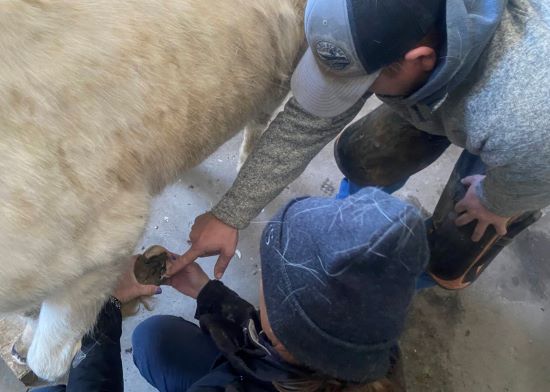
“My veterinarian and trimmer worked together to trim Romeo’s heels and find the angle that would provide some relief. On a day when it was only 8 degrees outside, I put on his Cavallos and marched him up to the garage in our house. With a heater going to keep us all warm, the veterinarian took radiographs and marked his hooves before the trimmer helped pare down his heels. While I trust my trimmer and know he does a good job, we needed to know how much was safe to trim. Romeo’s heels had grown so quickly, I wanted to take off as much as possible and help the trimmer feel assured that he wouldn’t hit anything painful.
“After two rounds of radiographs and trimming, the pair safely got enough heel off to set Romeo’s coffin bone down to a more pain-free angle. The radiographs showed where Romeo had been placing pressure on his hooves. The trimmer was able to center his weight back and off the painful laminae.
Saving a Family Member
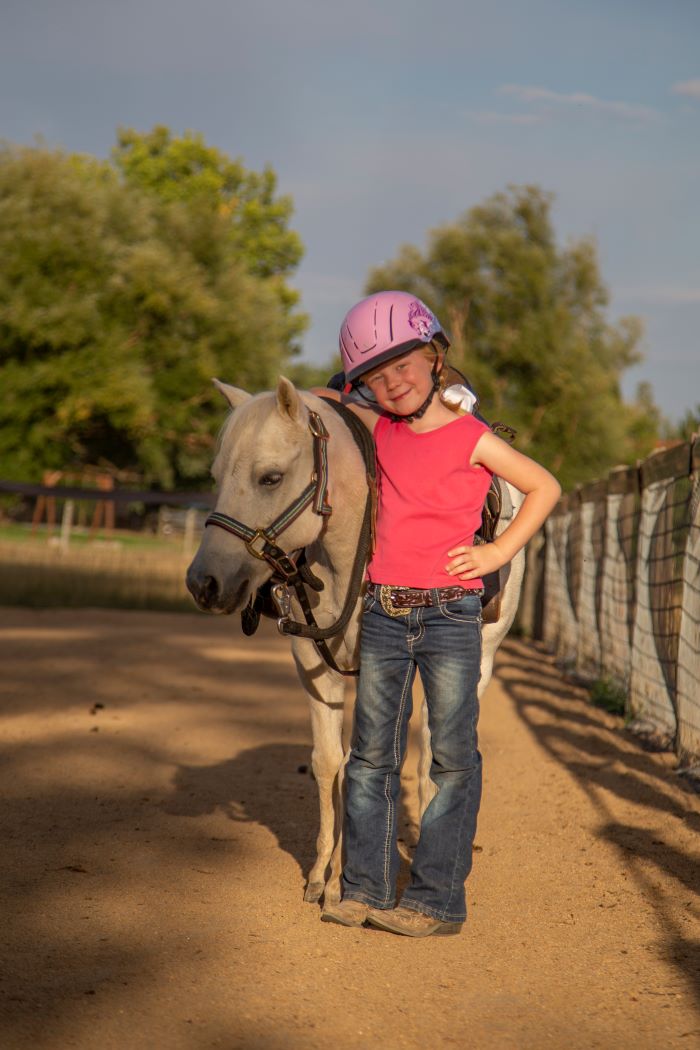
“You hear horror stories about ponies who ‘act like ponies’ and would be horrible to be around or work with. Romeo is quite the opposite. He’s a family member to us. He’s a sweet man who didn’t spook or balk at all being in the garage with humans moving him up and then off wood blocks for the radiographs. He’s a sweet man who has added so much to my life and I’ll do anything to keep him comfortable, cushioned, and feeling good. I trust that this spring and summer, he’ll be back in good shape–and only need his smaller Cavallos for his usual pony rides and walks down the road.”
We hope some of Heidi’s story about Winter Laminitis may help you. Make sure to check in with your veterinarian to find out what you can do to help your horses with Winter Laminitis–and have your Cavallos with pads ready to go, just in case. And remember – never throw your old, worn-out boots away! Tuck them away in case you need them for hoof rehab in the future. You’ll be glad you did if the need ever arises!
A Gift for You
If think Cavallo Boots could help your equine with Winter Laminitis or any other hoof issue and you need help getting started, please download this free guide I made. It has instructions for booting and also has beautiful testimonials from people who have helped make their horses more comfortable. I hope you like it.
Wishing you many happy trails,
-Carole


